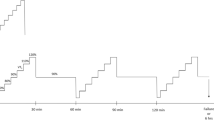Abstract
The isometric length-tension diagram for individual fibers and for whole muscle is considered, and it is proposed that the tensionp may be represented for any muscle whose fibers are parallel and not in series, in the form
where the form of ϕ is known and the same for all muscles, the parameters α and ł are experimentally measurable,x represents the length, β the degree of activity of the muscle, and the form off(x) varies from muscle to muscle.
Similar content being viewed by others
Literature
Asmussen, Erling. 1934. “Untersuchungen über die mechanische Reaktion der Skelettmuskelfaser.”Skand. Arch. f. Physiol.,70, 233–272.
Asmussen, Erling. 1936. “Über die Längen-Spannungs Kurven des ruhenden und des aktiven Muskels.”Skand. Arch. f. Physiol.,74, 129–141.
Bairati, Angelo. 1937. “Struttura e proprietà fisiche del sarolemma della fibra muscolare striata.”Zeit. Zellforsch. u. mik. Anat.,27, 100–124.
Banus, M. Garcia and Arnold M. Zetlin. 1938. “The Relation of Isometric Tension to Length in Skeletal Muscle.”J. Cell Comp. Physiol.,12, 403–420.
Brown, Dugald. 1936. “The Sequence of Events in the Isometric Twitch at High Pressure.”Cold Spring Harbor Symposia,4, 242–251.
Brown, Dugald. 1941. “The Regulation of Energy Exchange in Contracting Muscle.”Biol. Symp.,3, 161–190.
Buchthal, Fritz and J. Lindhard. 1939. “The Physiology of Striated Muscle.”Biol. Med. Kgl. Danske Vid. Selskab,14, No. 6.
Christen, Th. 1911. “Theoretischer Essai über Muskelmechanik.” Pfl.Arch. f. d. ges. Physiol.,142, 15–46.
Cowdry, E. V. 1938.A Textbook of Histology. 2nd ed. Philadelphia: Lea and Febiger.
Fenn, Wallace O. 1925. “Die mechanischen Eigenschaften des Muskels.” Bethe'sHdbch. d. Physiol.,8 (1), 146–165.
Gelfan, S. and R. W. Gerard. 1930. “Studies of Single Muscle Fibers. II. A Further Analysis of the Grading Mechanism.”Am. J. Physiol.,95, 412–416.
Hill, A. V. 1926.Muscular Activity. Baltimore. Williams and Wilkins.
Hill, A. V. 1938. “The Heat of Shortening and the Dynamic Constants of Muscle.”Proc. Roy. Soc. London, B126, 136–195.
Hill, A. V. and W. Hartree. 1920. “The Thermo-elastic Properties of Muscle.”Phil. Tr. Royal Soc. B210, 153–173.
Householder, Alston S. 1940. “A Neural Mechanism for Discrimination. III. Visually Perceived Lengths and Distances.”Bull. Math. Biophysics,2, 157–167.
Householder, Alston S. and H. D. Landahl. 1944.Mathematical Biophysics of the Central Nervous System. Bloomington: The Principia Press (in press).
Jacobson, Edmund. 1934. “Electrical Measurement of Activities in Nerve and Muscle.”The Problem of Mental Disorder, 133–145. New York: McGraw-Hill.
James, Hubert M. and Eugene Guth. 1944. “Theory of the Elasticity of Rubber.”J. Appl. Physics,15, 294–303.
Landahl, H. D., W. S. McCulloch and Walter Pitts. 1943. “A Statistical Consequence of the Logical Calculus of Nervous Nets.”Bull. Math. Biophysics,5, 135–138.
McCulloch, Warren S. and Walter Pitts. 1943. “A Logical Calculus of the Ideas Immanent in Nervous Activity.”Bull. Math. Biophysics,5, 115–134.
Matthews, Bryan H. C. 1933. “Nerve Endings in Mammalian Muscle.”J. Physiol.,78, 1–53.
Ramsey, Robert Weberg. 1944. “Muscle: Physics.” Glasser'sHandbook of Medical Physics, 784–798. Chicago: Year Book Publishers.
Ramsey, Robert W. and Sibyl F. Street. 1940. “The Isometric Length-tension Diagram of Isolated Skeletal Muscle Fibers of the Frog.”J. Cell. Comp. Physiol.,15, 11–34.
Ramsey, Robert W. and Sibyl F. Street. 1941. “Muscle Function as Studied in Single Muscle Fibers.”Biol. Symp.,3, 9–34.
Sichel, Ferdinand J. M. 1934. “The Elasticity of Isolated Resting Skeletal Muscle Fibers.”J. Cell. Comp. Physiol.,5, 21–42.
Washburn, Margaret Floy. 1916.Movement and Mental Imagery. Outline of a Motor Theory of the Complexer Mental Processes. Boston and New York: Houghton Mifflin Co.
Author information
Authors and Affiliations
Rights and permissions
About this article
Cite this article
Householder, A.S. Muscular dynamics and muscular efficiency: I. The isometric length-tension diagram of striated skeletal muscle. Bulletin of Mathematical Biophysics 7, 5–13 (1945). https://doi.org/10.1007/BF02478254
Issue Date:
DOI: https://doi.org/10.1007/BF02478254




